
A castle is a type of fortified structure built during the Middle Ages predominantly by the nobility or royalty and by military orders. Scholars usually consider a castle to be the private fortified residence of a lord or noble. This is distinct from a mansion, palace and villa, whose main purpose was exclusively for pleasance and are not primarily fortresses but may be fortified. Use of the term has varied over time and, sometimes, has also been applied to structures such as hill forts and 19th- and 20th-century homes built to resemble castles. Over the Middle Ages, when genuine castles were built, they took on a great many forms with many different features, although some, such as curtain walls, arrowslits, and portcullises, were commonplace.

Krak des Chevaliers, is a medieval castle in Syria and one of the most important preserved medieval castles in the world. The site was first inhabited in the 11th century by Kurdish troops garrisoned there by the Mirdasids. In 1142 it was given by Raymond II, Count of Tripoli, to the order of the Knights Hospitaller. It remained occupied by them until it was reconquered by the Muslims in 1271.

A concentric castle is a castle with two or more concentric curtain walls, such that the outer wall is lower than the inner and can be defended from it. The layout was square where the terrain permitted, or an irregular polygon where curtain walls of a spur castle followed the contours of a hill.
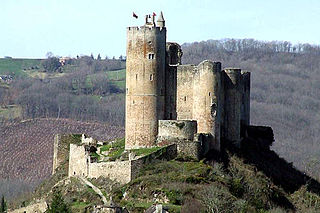
Château de Najac or the royal fortress of Najac is located in Najac, in the Aveyron département, in southern France.

Castel del Monte is a 13th-century citadel and castle situated on a hill in Andria in the Apulia region of southeast Italy. It was built during the 1240s by King Frederick II, who had inherited the lands from his mother Constance of Sicily. In the 18th century, the castle's interior marbles and remaining furnishings were removed. It has neither a moat nor a drawbridge and some considered it never to have been intended as a defensive fortress. However, archaeological work has suggested that it originally had a curtain wall.

Kerak Castle is a large medieval castle located in al-Karak, Jordan. It is one of the largest castles in the Levant. Construction began in the 1140s, under Pagan and Fulk, King of Jerusalem. The Crusaders called it Crac des Moabites or "Karak in Moab", as it is referred to in history books. It was also colloquially referred to as Krak of the Desert.

Sahyun Castle, also known as the Castle of Saladin, is a medieval castle in northwestern Syria. It is located 7 km east of Al-Haffah town and 30 km east of the city of Latakia, in high mountainous terrain on a ridge between two deep ravines and surrounded by forest, the site has been fortified since at least the mid 10th century. In 975 the Byzantine Emperor John I Tzimiskes captured the site and it remained under Byzantine control until around 1108. Early in the 12th century the Franks assumed control of the site and it was part of the newly formed Crusader state of the Principality of Antioch. The Crusaders undertook an extensive building programme, giving the castle much of its current appearance. In 1188 it fell to the forces of Saladin after a three-day siege. The castle was again besieged in 1287, this time both defender and belligerent were Mamluks. In 2006, the castles of Qal'at Salah El-Din and Krak des Chevaliers were recognised as a World Heritage Site by UNESCO. The site is owned by the Syrian government.

The Château de Puivert is a so-called Cathar castle situated in the commune of Puivert, in the Aude département of France. The castle has been classified as a monument historique by the French Ministry of Culture since 1902. This building, on top of a hill overhanging the village and its lake, reaches an elevation of 605 m. The site is in the Quercob region, 60 km (37 mi) south of Carcassonne and 45 km (28 mi) east of Foix.
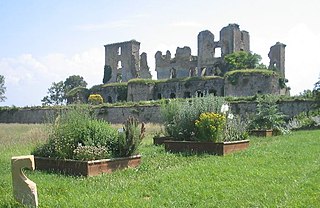
The Château de Lagarde is a ruined castle situated near the village of Lagarde, 8 km (5 mi) southeast of Mirepoix in the French département of Ariège.

The inner bailey or inner ward of a castle is the strongly fortified enclosure at the heart of a medieval castle. It is protected by the outer ward and, sometimes also a Zwinger, moats, a curtain wall and other outworks. Depending on topography it may also be called an upper bailey or upper ward.
The Château d'Harcourt, situated in the commune of Harcourt in the Eure department of France, is the cradle of the Harcourt family. The castle is one of the best preserved castles in the country and contains the oldest arboretum in France.
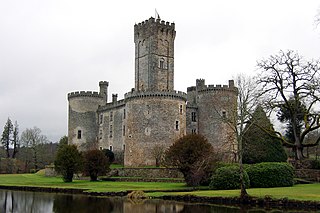
The Château de Montbrun is a castle in the commune of Dournazac in the Haute-Vienne département of France. The castle was built in the 12th and 15th centuries, and was restored in the late 19th century.

The Château de Rully is a castle in the commune of Rully in the Saône-et-Loire département of France. Located on the side of a hill, the castle dominates the whole region, facing the plain leading to the Saône. To the west, it commands the valley towards Nantoux and Chassey-le-Camp.
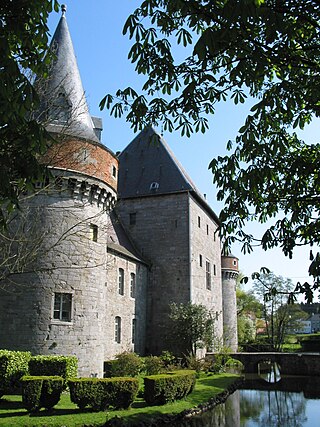
Solre-sur-Sambre Castle is a water castle in Solre-sur-Sambre in the municipality of Erquelinnes, province of Hainaut, Wallonia, Belgium. It is one of the oldest fortified castles in Hainaut, and the property of the Princes de Merode.

A bailey or ward in a fortification is a leveled courtyard, typically enclosed by a curtain wall. In particular, an early type of European castle was known as a motte-and-bailey. Castles and fortifications may have more than one bailey, and the enclosure wall building material may have been at first in wood, and later transitioned to stone. Their layout depends both on the local topography and the level of fortification technology employed, ranging from simple enclosures to elaborate concentric defences. In addition to the gradual evolution of more complex fortification plans, there are also significant differences in regional traditions of military architecture regarding subdivisions into baileys.

Bergfried is a tall tower that is typically found in castles of the Middle Ages in German-speaking countries and in countries under German influence. Friar describes it as a "free-standing, fighting-tower". Its defensive function is to some extent similar to that of a keep in English or French castles. However the characteristic difference between a bergfried and a keep is that a bergfried was typically not designed for permanent habitation.

In medieval fortification, a bretèche or brattice is a small balcony with machicolations, usually built over a gate and sometimes in the corners of the fortress' wall, with the purpose of enabling defenders to shoot or throw objects at the attackers huddled under the wall. Depending on whether they have a roof, bretèches are classified in two types: open and closed. The open ones were accessed from the battlement's wall walk, or from a crenel.

A flanking tower is a fortified tower that is sited on the outside of a defensive wall or other fortified structure and thus forms a flank. From the defensive platform and embrasures the section of wall between them could be swept from the side by ranged weapons. In High and Late Medieval castles and town walls, flanking towers often had a semi-circular floor plan or a combination of a rectangular inner and semi-circular outer plans. There were also circular and rectangular towers. Corner flanking towers are found, for example, in the fortifications of the Alhambra and at the manor house of Hugenpoet Palace; Wellheim Castle has a square flanking tower. Semi-circular flanking towers were common in Sasanian architecture.

A Zwinger is an open kill zone area between two defensive walls that is used for defensive purposes. Zwingers were built in the post-classical and early modern periods to improve the defence of castles and town walls. The term is usually left untranslated, but is sometimes rendered as "outer courtyard", presumably referring to the subsequent role of a Zwinger as a castle's defences became redundant and it was converted into a palace or schloss; however, this belies its original purpose as a form of killing ground for the defence. The word is linked with zwingen, "to force", perhaps because the Zwinger forced an enemy to negotiate it before assaulting the main defensive line. Essenwein states that the "main purpose of this feature was so that the besieging force could not reach the actual castle wall very easily with battering rams or belfries, but had to stop at the lower, outer wall; also that two ranks of archers, behind and above one another, could fire upon the approaching enemy".
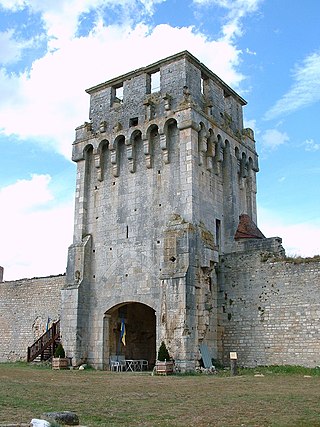
Château de Druyes is a medieval castle located in Druyes-les-Belles-Fontaines in Yonne, Bourgogne-Franche-Comté. It was built in the 12th century by the Counts of Nevers, and remained in their possession until the 18th century. It was as much a noble residence as it was a fortified castle. It was a frequented dwelling place of Peter II of Courtenay, the Emperor of Constantinople in the 13th century, and his daughter Matilda, Countess of Nevers, Auxerre and Tonnerre.































